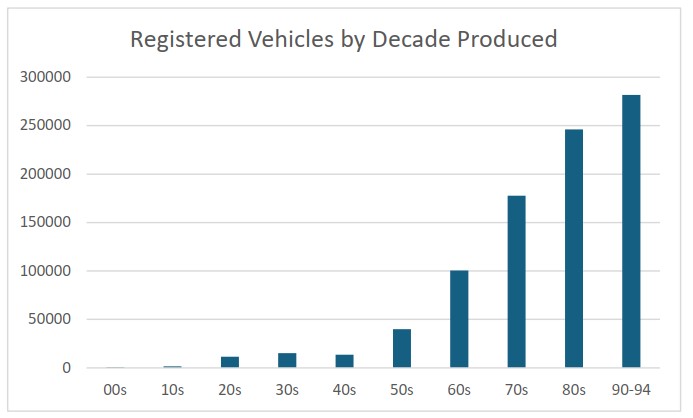THE FUTURE FOR HISTORIC VEHICLES
CHMC monitors issues, trends and developments that affect the future of historic vehicles and their operation. Our contacts, in Australia and internationally, include peak bodies in historic motoring, and operating heritage groups and government agencies, through them we obtain factual and reliable information and have opportunities to advocate to them on the future of historic vehicles. CHMC is collaborating with OHA, NHMA and AHMF in the Engineers Australia/University of Canberra survey into the volume of fossil fuels and lubricants that are required to keep heritage and historic vehicles and machines fully functioning into the future.
In 2024 the University of Canberra conducted a survey of the Australian operating heritage sector to collect data on the amount and types of fossil fuels used in this sector. In addition, it was possible to obtain information from regulators which has allowed us to measure the total size of the different operating heritage sectors.
The aim was to ensure that the results were representative of the sectors and accurate. A sampling method complying with Australian Bureau of Statistics guidelines was used. The sampling method was set to ensure that results were obtained from states, cities, regions, and types of vehicles in proportion to their size.
Thank you to all those who responded. The response was extremely good from most areas. The overall, Australia-wide, results have a 99% confidence level (ie. we can be confident that the results represent the historic vehicle fleet across Australia) and that they are accurate to within +/- 2.5%) The number of responses from Victoria, NSW, Queensland and Western Australia has also allowed us to derive results within each state and to compare these with other states. The accuracy of these states’ results vary from +/- 2% to +/- 4% - very good results! Unfortunately, the number of responses from South Australia and Tasmania were not sufficient to allow any detailed conclusions to be drawn from those results.
Some interesting results so far:
• Using the international definition of “historic”; ie. a vehicle over 30 years old, there were approximately 890,000 historic vehicles registered in Australia on 31 January 2024. This number is growing each year as more vehicles reach 30 years old.
• If we use the individual states’ definitions, some over 30 years, some over 25 years, the number is over 1.2 million vehicles.
If you’re wondering what the future historic vehicle sector might look like, this graph might give a clue. 
The number of historic vehicles in each state is shown below:

Interestingly, there were 1,538,927 registered historic vehicles (older than 30 years) in the UK in 2020. Per head of population, the UK has 23 historic vehicles per 100,000 people, Australia has 33 historic vehicles per 100,000 people. Australians clearly like their historic vehicles!
Next steps
Unfortunately there has been a delay in the University of Canberra making more information available. We expect more information to be available in July and this will allow us to calculate the amount of fuel and lubricants needed in the future and will be used in our discussions with The Commonwealth Department of Transport as they produce their Net Zero Strategy (ensuring historic vehicles are protected) and with suppliers and producers of renewable e-fuels (safe, reliable “drop-in” fuels).
For more information, please email Operating Heritage Australia or look at our Facebook site Operating Heritage Australia | Facebook
HOW MUCH CARBON DOES YOUR HISTORIC VEHICLE EMIT?
OPERATING HERITAGE AUSTRALIA HAS SHARED WITH US A TABLE FOR CALCULATING WHERE YOUR VEHICLE’S KM/YEAR INTERSECTS WITH ITS FUEL CONSUMPTION TO FIND CO2 EMITTED IN KG.
On the table, also online in CHMC's DINKUM OIL #23 MAY 2023 find where your vehicle’s km/year intersects with its fuel consumption to find CO2 emitted in kg.
For example - based on the latest FIVA survey, Australian historic cars travel, on average, around 1200 km/yr and, if we assume a 14L/100km (20mpg) fuel consumption, then the amount of carbon dioxide produced is 504kg for the year
ELECTRIC DRIVE CONVERSIONS OF HISTORIC VEHICLES
PEAK BODIES FOR HISTORIC MOTORING AROUND THE WORLD CAUTION OWNERS TO CAREFULLY CONSIDER ALL ASPECTS OF THE ENGINEERING, COMPLIANCE, REGISTRATION, ENVIRONMENTAL AND HERITAGE IMPLICATIONS BEFORE UNDERTAKING A CONVERSION AND COMPROMISING THE HERITAGE/HISTORIC STATUS OF THEIR VEHICLE
-
The FIVA Position Statement on EV Conversions
-
CHMC's Position paper on Conversion of Heritage Vehicles to Electric Drive
E-FUELS FOR HISTORIC VEHICLES?
The FIVA Working Group on eFuels monitored successful tests of e-Fuels in vehicles aged from 1901 to the 1970s, including a 1922 Aston Martin in the Centenary 2022 Gran Prix; a 1936 Aston Martin raced at the GP Nuvolar; and a VW T1 bus that toured 3,500kms on the 2022 Olympia Rally.
Conclusion – “e-Fuel workS and did not harm historic vehicles ”.
A 1901 Mors and a 1904 Covert completed the 2022 London-Brighton without any problems on e-Fuel.
SINCE THEN many more historic and heritage vehuicles have been operating satisfactorily on rallies and tours in the UK and Europe.
OPERATING HISTORIC VEHICLES IN A TIME OF ENVIRONMENTAL CHANGE. Have you read the FIVA Environmental Guide, a positive approach towards environmental protection and practical support for environmentally conscious use of historic vehicles.
THE FUTURE OF HISTORIC VEHICLES. Have you read: the FIVA Position Statement on Historic Vehicles and Global Climate Change